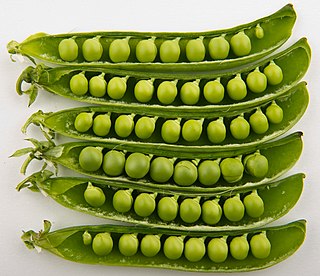
Pea is a pulse, vegetable or fodder crop, but the word often refers to the seed or sometimes the pod of this flowering plant species. Carl Linnaeus gave the species the scientific name Pisum sativum in 1753. Some sources now treat it as Lathyrus oleraceus; however the need and justification for the change is disputed. Each pod contains several seeds (peas), which can have green or yellow cotyledons when mature. Botanically, pea pods are fruit, since they contain seeds and develop from the ovary of a (pea) flower. The name is also used to describe other edible seeds from the Fabaceae such as the pigeon pea, the cowpea, the seeds from several species of Lathyrus and is used as a compound form for example Sturt's desert pea.

Pediomelum esculentum, synonym Psoralea esculenta, common name prairie turnip or timpsula, is an herbaceous perennial plant native to prairies and dry woodlands of central North America, which bears a starchy tuberous root edible as a root vegetable. English names for the plant include tipsin, teepsenee, breadroot, breadroot scurf pea, large Indian breadroot, prairie potato and pomme blanche. The prairie turnip continues to be a staple food of the Plains Indians.

Pediomelum hypogaeum is a perennial herb also known as the little Indian breadroot or subterranean Indian breadroot. It is found on the black soil prairies in Texas.

Olea europaea subsp. cuspidata is a subspecies of the well-known olive tree, which until recently was considered a separate species and is still mentioned as such in many sources. Native to mostly dry areas across sub-saharan Africa, West Asia, the Himalayan region and southern China, it has various common names, including wild olive, African olive, brown olive and Indian olive.
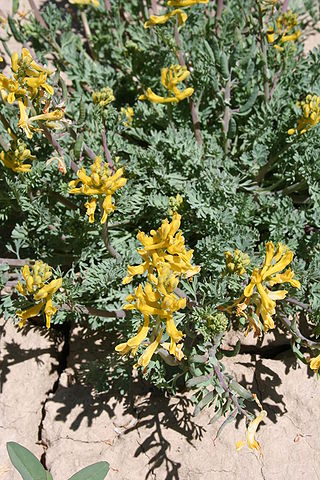
Corydalis aurea, also known as scrambled eggs, golden smoke, or golden corydalis, is a flowering plant in the poppy family (Papaveraceae). The plant has a broad range stretching across North America and is able to thrive within a variety of ecosystems. The plant possesses numerous distinct characteristics. Its fruit most closely resembles that of a pea pod and is typically around 3/4 of an inch in length. The plant has numerous medicinal uses, as well as uses for gardens.

Lathyrus niger, also known as black pea, blackening flat pea and black bitter vetch, is a perennial legume that is native to Europe. Its common name is reference to the blackening of the plant's foliage as it dies.

Pediomelum is a genus of legumes known as Indian breadroots. These are glandular perennial plants with palmately-arranged leaves. They have a main erect stem with inflorescences of blue or purple flowers and produce hairy legume pods containing beanlike seeds. Some species have woody roots while others have starchy tuber-like roots which can be eaten like tuber vegetables such as potatoes or made into flour. Indian breadroots are native to North America. Many species have synonymy with genus Psoralea.

Chenopodiastrum murale, is a species of plant in the family Amaranthaceae known by the common names nettle-leaved goosefoot, Australian-spinach, salt-green, and sowbane. This plant is native to Europe and parts of Asia and northern Africa, but it is widespread worldwide, particularly in tropical and subtropical areas due to the ease of it being introduced. It is a common weed of fields and roadsides.
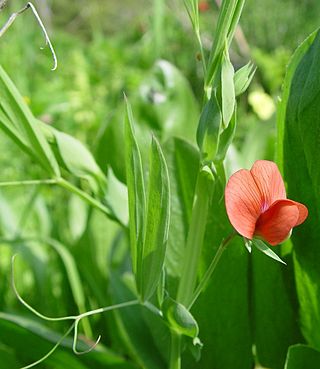
Lathyrus cicera is a species of wild pea known by the common names red pea, red vetchling and flatpod peavine. It is native to Europe, North Africa, and the Middle East, and it is known from other places as an introduced species. This is a hairless annual herb producing a slightly winged stem. The leaves are each made up of two leaflike linear leaflets 3 to 6 centimeters long. They also bear branched, curling tendrils. The inflorescence holds a single pea flower 1 to 1.5 centimeters wide which is a varying shade of red. The fruit is a hairless dehiscent legume pod.

Lathyrus palustris is a species of wild pea known by the common name marsh pea. It is native to Europe, Asia, and North America. It is a perennial herb with leaves made up of oval-shaped or oblong leaflets a few centimeters long. It has branched, coiled tendrils. The plant bears an inflorescence of two to eight pinkish purple pea flowers each up to two centimeters wide. The fruit is a dehiscent legume pod.

Tephrosia virginiana, also known as goat-rue, goat's rue, catgut, rabbit pea, Virginia tephrosia, hoary pea, and devil's shoestring is a perennial dicot in family Fabaceae. The plant is native to central and eastern North America.

Chorizanthe cuspidata is a species of flowering plant in the buckwheat family known by the common name San Francisco spineflower. It is endemic to California, where it is known only from the San Francisco Bay Area and to the immediate north and south. It grows in sandy coastal habitat.
Pediomelum castoreum is a species of flowering plant in the legume family known by the common names beaver Indian breadroot and beaver dam breadroot. It is native to the deserts around the intersection of California, Nevada, and Arizona, where it grows in local habitat including disturbed areas. It is a perennial herb with no stem or a short stem that is mostly underground, leaving the plant at ground level. The compound leaves are each made up of five or six oval leaflets which may be over 4 centimeters long. The leaf is borne on a long petiole. The inflorescence is a raceme of several blue or purple pealike flowers each roughly a centimeter long. The fruit is a hairy oval legume pod tipped with a long, curved beak. It contains ridged gray seeds each about 6 millimeters long.
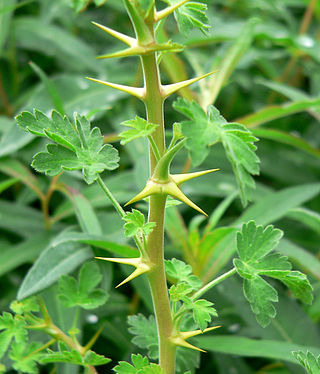
Ribes montigenum is a species of currant known by the common names mountain gooseberry, alpine prickly currant, western prickly gooseberry, and gooseberry currant. It is native to western North America from Washington south to California and east as far as the Rocky Mountains, where it grows in high mountain habitat types in subalpine and alpine climates, such as forests and talus. It is a spreading shrub growing up to 1.5 meters tall, the branching stems covered in prickles and hairs and bearing 1 to 5 sharp spines at intervals.

Passiflora suberosa is a species of passionflower that is native to the Americas. It is commonly known as corkystem passionflower due to the corkiness of older stems. Other common names include corky passion vine, cork-bark passion flower, corkstem passionflower and corky passionfruit. In Latin America it is called Meloncillo. It is possibly also cryptic and have multiple species in one.
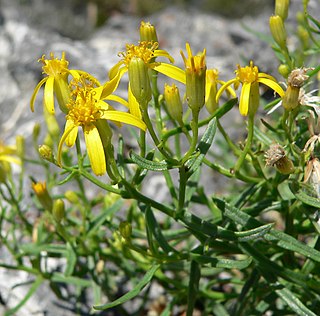
Senecio spartioides is a species of flowering plant in the aster family known by the common name broom-like ragwort. It is native to the western United States as far east as the Dakotas, Texas, and northern Mexico. It can be found in dry, rocky, often disturbed areas in various habitat types. It is a subshrub which can exceed a meter in height, its arching stems growing from a woody-topped taproot. The leaves are linear in shape and up to 10 centimeters long. The leaves usually have smooth, unlobed edges, but slightly lobed leaves are seen at times. The leaves are evenly distributed along the stems, the ones low on the stems withering away early, giving the plant a naked appearance on the lower half while the top is still lush green and blooming. The inflorescences are spreading, flat-topped arrays of many cylindrical flower heads. The heads contain yellow disc florets and generally either 5 or 8 ray florets each about a centimeter long.
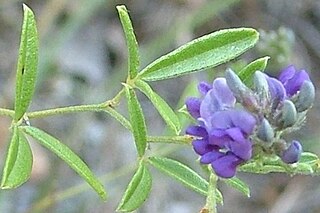
Pediomelum tenuiflorum, the slimflower scurfpea, is a perennial in the pea family. It is about 2–3 feet (0.6–0.9 m) tall and has a lot of leaves on top. Its leaves can reach a length of 3 inches (80 mm). This flower can be found mainly in the central and southwestern U.S.

Aeschynomene indica is a species of flowering plant in the legume family. Common names include Indian jointvetch, kat sola, budda pea, curly indigo, hard sola, northern jointvetch, indische Schampflanze (German), angiquinho, maricazinho, papquinha, pinheirinho, he meng (Chinese), kusanemu (Japanese), diya siyambala (Sinhala), and ikin sihk (Pohnpeian).

Sphagnum cuspidatum, the feathery bogmoss, toothed sphagnum, or toothed peat moss, is a peat moss found commonly in Great Britain, Norway, Sweden, the eastern coast of the United States, and in Colombia.
Genoplesium cuspidatum is a species of small terrestrial orchid endemic to eastern Australia. It has a single leaf fused to the flowering stem and between 6 and 28 reddish to dark purple flowers with prominent darker stripes.




















